In a mission filled with unexpected surprises, NASA's New Horizons spacecraft has left its scientists awed by the array of landforms and compositions found on Pluto and Charon.
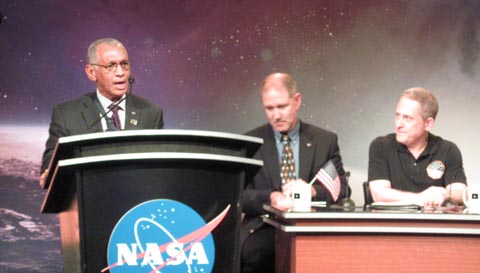
S&T: J. Kelly Beatty
The post-arrival rush for any NASA interplanetary mission follows a predictable pattern. First, scientists show reporters early results that often underscore how little they really knew about the spacecraft's objective (which, after all, is why they're exploring it). Then comes a press briefing at which officials from NASA Headquarters congratulate the team on a job well done. For the New Horizons mission, both of those took place yesterday.
Third comes the first glimpse of the scientific revelations waiting to be harvested in the spacecraft's trove of findings. That moment came today, when mission scientists showed off images of Pluto and Charon that had been radioed back to Earth early this morning. They only discussed surfaces — what's been learned about the atmosphere of Pluto (and perhaps Charon's), along with the planet's interaction with the solar wind, will be announced later this week.
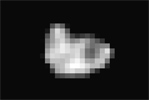
NASA / JHU-APL / SWRI
To tease the crowded auditorium at Johns Hopkins University's Applied Physics Laboratory in Laurel, Maryland, which serves as the mission's control center, JHU-APL mission scientist Hal Weaver introduced a close-up of the small moon Hydra. It, along with Nix, were found circling Pluto in 2005 by the Hubble Space Telescope.
Measuring 28 by 19 miles, Hydra is at the small end of the range of possible sizes derived from Hubble observations. This suggests that it's mostly water ice, which reflects sunlight well. Hydra also looks to be a fragment of a larger object. Perhaps taking a jab at the International Astronomical Union's controversial definition of planethood, Weaver quipped, "It's an elongated object. Hydra is not a planet."
Charon: Surprisingly Dynamic
Next came a dramatic close-up of Charon, which exhibits far more geologic diversity than anyone expected. "Originally, I thought Charon would show an ancient terrain covered in craters," admitted deputy project scientist Cathy Olkin (Southwest Research Institute). But today's highly detailed image "blew our socks off."
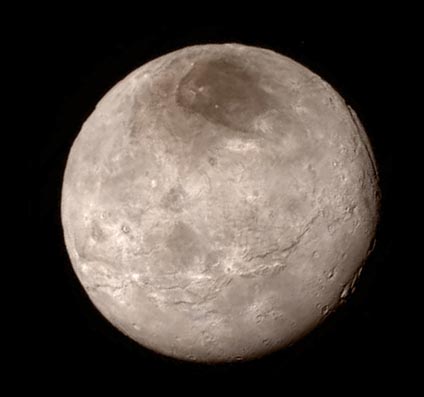
NASA / JHU-APL / SWRI
The dark polar cap seen in earlier views (and informally dubbed Mordor) turns out to have more to it than just a reddish stain. There's some kind of structure — perhaps a large impact basin — capping this moon. Here and there are deep fractures, one a gash of deep, interconnected canyons that slashes across the surface for some 600 miles (1,000 km). And some regions look smooth and crater-free, a telling sign that they're relatively young in age.
Has Charon been churning inside to cause all this geologic calamity? Perhaps, but Olkin and her colleagues won't have to wait long to know more. Images with five times better resolution will be radioed to Earth by the spacecraft in the days ahead.
Perplexing Pluto
Charon's geologic diversity is eye-popping, but Pluto's is stealing the show. Mission geologists are still trying to figure out what created the large, bright heart-shaped feature in the dwarf planet's equatorial region. But they know what they're going to be calling it: Tombaugh Regio, to honor Pluto's discoverer. "We could see the heart from far away, 70 million miles, shining like a beacon as the brightest feature on the planet," explains Alan Stern, the mission's principal investigator, "so that's why we want to call it Tombaugh Regio." (IAU approval is still needed for it to become official.)
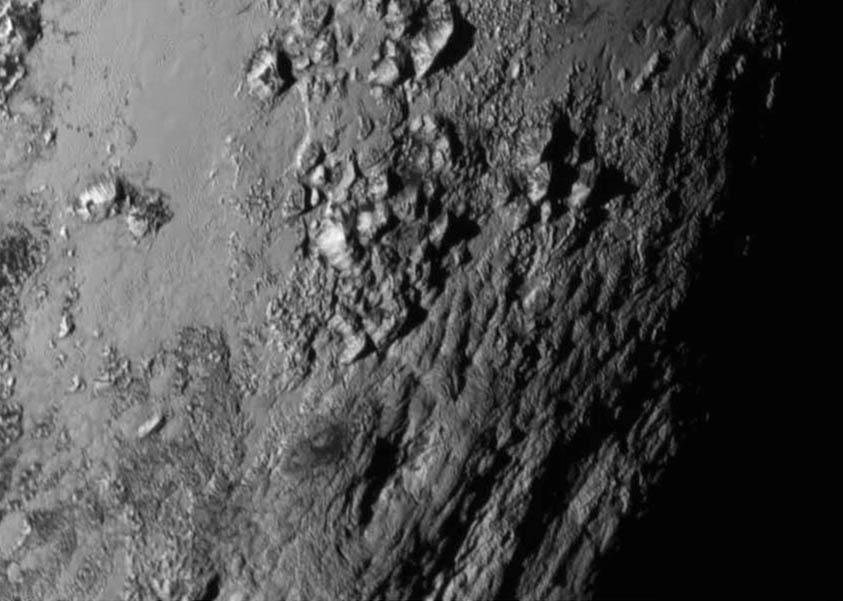
NASA / JHU-APL / SwRI
The one highly detailed image of Pluto revealed today was a small piece of the planet that has some very rough terrain and a clutch of mountains rising up to 11,000 feet (3½ km). That's far too tall, notes John Spencer (Southwest Research Institute) to be big piles of the frozen nitrogen and methane that dominate Pluto's spectrum. Instead, the underlying "rock" must be stiffer, sturdier water ice — something long suspected by cosmochemists but undetected in surface spectra.
Spencer is even more amazed by what's missing from the high-resolution image: craters. In fact, says Spencer, "We have not found a single impact crater on this image." Given enough time, any solid surface in the solar system is going to get whacked by interplanetary debris. So the lack of craters tells planetary geologists that this part of Pluto must be relatively young — no older than about 100 million years. "It could be active right now," Spencer says.
At one time planetary scientists imagined that Pluto would look something like Neptune's big moon, Triton. After all, the two are alike in size. But the theme that keeps emerging from New Horizons' early results is that Pluto is not like Triton at all and, in fact, is unlike anything yet seen in the solar system. "This is the first time we've seen an icy world that isn't the moon of a giant planet," Spencer explains. So tidal heating can't be invoked to heat the interior and power all the dynamic geology on display.
Stern was quick to point out that Pluto is losing what little atmosphere it has quickly, at a rate of tons per second. Over the history of the solar system, that means Pluto has lost enough nitrogen to form a global layer 0.3 to 3 km deep. Whatever nitrogen we see today is just a veneer, he explains, and to exist on the surface at all, some process must be dredging up nitrogen from Pluto's interior. "We haven't found geysers or cryovolcanoes yet," Stern says, "but now we'll be looking for exactly the evidence of these phenomena."
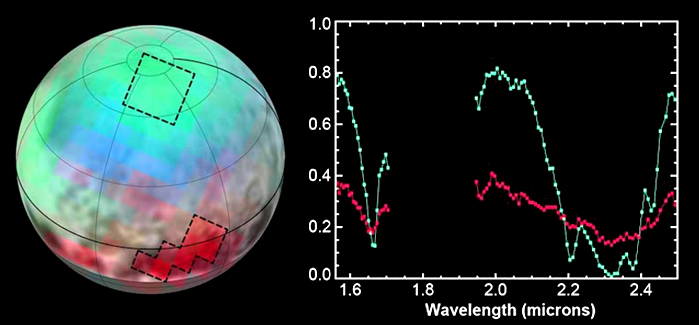
NASA / JHU-APL / SWRI
One reporter today suggested that the discoveries found so far haven't risen to the level of "balloon-popping" excitement that accompanied Mariner 4's flyby of Mars in 1965. That statement drew an immediate rebuttal from the mission's scientists. From Stern: "I didn't expect Charon to show nearly the degree of different terrains or the youthful surface. That's a complete surprise. That's a balloon popping."
He went on: "Also finding, in one image showing 1% of the surface of Pluto, mountains as big as the Rockies is a balloon popping."
From Weaver: "Just seeing mountains was a complete surprise. We had so much trouble finding any evidence for water on the surface of Pluto."
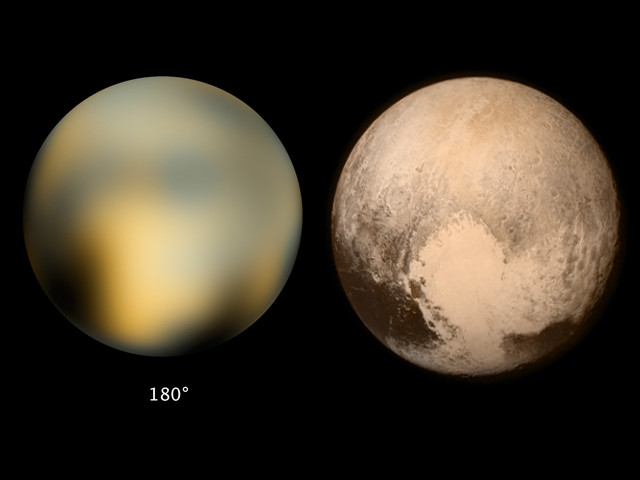
Hubble: NASA / ESA / M. Buie; New Horizons: NASA / JHU-APL / SWRI (courtesy Scott McCartney)
From Spencer: "I would never have believed that the first close-up picture we get of Pluto would not have a single impact crater on it."
From Wil Grundy (Lowell Observatory): "The false-color image shown yesterday showing the great range of compositional units on the surface, and the photographs that show the great range of morphology on the surface, point in my head to a great diversity of processes working." It's a much more complicated system with a "huge palette of processes that are working in different ways on different parts of the surface."
These early results are really just a tantalizing tease. In fact, the mission scientists have often demurred when ask to speculate about what they're seeing. After all, vastly better observations are sitting patiently in storage aboard the spacecraft, waiting for their turn to be sent to Earth. We'll get another dose of early results at the next press briefing, now scheduled for Friday afternoon.
 9
9









Comments
jaime
July 15, 2015 at 10:30 pm
Wou !! Well done 4 new horizons mission
You must be logged in to post a comment.
Kevin
July 17, 2015 at 6:34 pm
Bravo team! Both Pluto and Charon have incredibly diverse surfaces and thanks for giving us the chance to see them. Well done!
You must be logged in to post a comment.
Karl
July 16, 2015 at 1:25 pm
I used a Gaussian blur to de-pixelate the image of Hydra - I think it's easier to visualize that way.
I couldn't see any other way to upload an image, so I used it as my profile photo... should be visible above. Hopefully we will be getting higher res images of the small moons!
You must be logged in to post a comment.
Robert-Casey
July 16, 2015 at 3:48 pm
In the above picture of Charon, at the 4 o'clock position, there's a mountain in a moat. As if the land under and around that mountain got soft down below the surface and went squish. What would cause a melting of that underneath?
You must be logged in to post a comment.
Karl
July 16, 2015 at 4:25 pm
Giant volcanoes like the Hawaiian Islands do something like that to the seafloor on Earth.
But maybe more likely, if the mountain is a cryovolcano the (relatively) hot water-ammonia "lava" might have vaporized and driven off more volatile ices in the crust (like nitrogen, methane or carbon monoxide). That could make for a spectacular eruption surrounded by geysers...
You must be logged in to post a comment.
Robert-Casey
July 16, 2015 at 6:45 pm
New version of that stamp
http://www.wa2ise.com/space/Pluto_Stamp.jpg
Says "Now explored" and shows the heart
You must be logged in to post a comment.
Kevin
July 17, 2015 at 6:49 pm
I hope the IAU rethinks Pluto status now that we've seen it up close because it makes it more "real" as a planet. Before the New Horizons mission, it was just that strange icy object with a big icy moon near (or is it officially residing in?) the Kuiper Belt. Has the term
"cryo-geologically active" been used yet? When I hear "geologically active" I always think of plate tectonics and subsurface magma pools.
You must be logged in to post a comment.
Antonio Mario
July 17, 2015 at 9:54 pm
Kevin, with due respect, and I'm no planetary expert, but why a planet now? This is the first Kuiper belt object studied in detail; others might show similar features. And, look at Pluto's orbit, etc. Finally, I haven't read from anyone on the New Horizons team argue for that, as it wouldn't be reasonable.
Cheers.
You must be logged in to post a comment.
GH Martin
July 21, 2015 at 3:00 pm
Is it possible that Pluto's apparent lack of craters is not because of a youthful surface, but rather, the lack of things hitting it? All the other surfaces we have for comparison are in the Inner Solar System, and Pluto is the first Kuiper Belt object we've seen up close. There has to be many, many more impacts occurring in the Inner Solar System (Neptune inward) than way out there in the Kuiper Belt. If the current theory for the formation of our Moon is correct, there was a huge amount of rock blasted out into the entire Inner Solar System from the impact; hardly any of which would have made it out to Pluto.
You must be logged in to post a comment.
You must be logged in to post a comment.